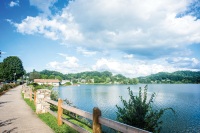Not your average tourist: Waynesville man reflects on decades of travel in the jungles of Ecuador
 When life gets hectic, most people have a vacation spot where they go to unwind — perhaps a family cabin on the lake, a favorite campground or a sandy beach.
When life gets hectic, most people have a vacation spot where they go to unwind — perhaps a family cabin on the lake, a favorite campground or a sandy beach.
David Burns, 73, finds that place somewhere in the depths of the Ecuadorian Amazon.
“For me, it’s an escape,” said Burns, who moved to Waynesville from Key West, Florida, 4 years ago. “For years and years I ran a private investigation agency, and I’m also a pianist. This is just so far away from the world that I lived in that just the dichotomy was interesting to me.”
Over the last 27 years, he’s made just short of 20 trips to the Ecuadorian Amazon, a tradition that started by happenstance back in 1989. Burns had been planning to visit Scotland that year, but he realized he couldn’t make it happen given his bank account. Then he learned that a friend of his, an emergency room doctor, was headed to Ecuador. Burns tagged along. He loved the country. And he kept going back.
“It was like my second home,” he said.
Though Ecuador, at least the way Burns does it, is substantially less luxurious than most second homes. He avoids “rich Americans” “like the plague,” setting his sights on the smallest, most remote villages in the jungle, occupied by native people whose day-to-day experience of life is far removed from the buildings and banks and fast-paced transportation that govern so much of the world.
Related Items
His trips south include little luxury but plenty of bushwhacking, backcountry paddling and sweaty battle with the multitude of insects that inhabit the jungle.
Travel with risk
When Burns first began to explore Ecuador, his travels focused on the Shuar people. He’d been fascinated with them since the age of 10, when he saw the documentary Jungle Headhunters, which highlighted the Shuar practice of shrinking a deceased enemy’s head to incapacitate its soul.
“Up until that time I was absolutely sure I was going to be a pirate, but then I saw that movie and the world changed,” Burns said.
The Shuar don’t shrink heads anymore. Once Burns met a man — the oldest in the village — whose father had done it, but that’s the closest he came. His fascination with the Amazonian people remained, however. He kept returning, though he eventually shifted his focus to the Huaorani people, a smaller but fiercer tribe occupying land adjacent to the Shuar. He’d read a series of articles about the Huaorani in The New Yorker — they would later be compiled as the book Savages — and was inspired to go visit himself.
By the next year, 1994, he’d made it happen, though he now terms that particular venture “foolhardy.” The guide he hired had traveled the rivers before, but he wasn’t Huaorani, and he didn’t speak Huaorani. They made it to the village after a seven-hour river trip, and stayed a week. But the peace there was uneasy, Burns recalls.
“After a week I was kind of glad to be leaving,” he said. “You know when you go to somebody’s house and they have a big dog and you keep giving them treats? You keep saying, ‘What happens when I run out of treats?’”
Burns has come through his travels mostly unscathed, but when traveling the Amazon injury and even death aren’t out of the question.
In February, for instance, Burns found out that a guy he knew had been killed by the Huaoranis. After a “minor massacre” two years before, two girls had been abducted. The Huaoranis thought Burns’ friend Kaiga Baiwa, had been involved.
“He was ambushed down there and killed. His wife survived,” Burns said.
To travel with some degree of safety, you’ve got to be connected enough to find a good guide who knows the place and its people, and you’ve also got to be flexible in your itinerary. Sometimes, intertribal conflicts make travel to the initial destination impossible.
“There are times when you can go there and times when you can’t go there,” Burns said. “So if you can’t go there, there are a million places in Ecuador that are beautiful.”
Witnessing change
It’s a beautiful country, but it’s also changing. Usually, Burns plans each trip to take in a different village, a different group of people. The cultures are as diverse as the villages that house them, with each group of people distinct from the others. He enjoys the novelty of going somewhere new each time.
But in 2014, the 20th anniversary of Burns’ first trip to the Huaorani region of Ecuador, he decided to return to the village he’d seen on that first visit.
“A lot had changed,” he said.
Government buildings, hotels and medical clinics can now be found deeper in the jungle than they once could. The village that Burns first witnessed as being made out of more traditional building materials is now composed of board-built buildings.
After his first trip to the Huaorani, a little dirt road leading to this “nasty oil town” led Burns to write an essay about the 8.5-hour drive. Today the drive takes more like four hours. The hotel he’d stayed at the first time there was “very basic to say the least,” but these days it’s a bonafide hotel.
“Wait 20 years and things change,” Burns said.
One thing that hasn’t changed, however, is the respect Burns has for the native people of Ecuador.
“They’re so stoic and they are so strong that it’s just amazing,” Burns said.
That realization began during one of his first trips, with his friend the ER doctor. A man in the village had injured his eye while preparing a blowgun dart before the group arrived, a “horrible-looking” injury that must have caused extreme pain.
When it was communicated to him that one of the newly arrived Americans was a doctor and could help him, the man simply lay down on the floor and waited as the doctor peeled his eyelid back and dressed the injury.
“This guy did not flinch, did not make a sound. Absolutely stoic. That is a strong dude,” Burns recalled. “After spending time in the jungle with them and seeing what they do, it’s just amazing. They have physical strength, they have strength of character.”
People to admire
Flipping through a file of photographs on his computer, Burns comes to image after image that reinforces that assessment. There’s one of a much-shorter Huaorani man standing placidly next to a red-faced Burns. They’d just come out of the jungle after an excursion that tested Burns’ limits more than just about anything else he’d done in the past.
“I’d never been that hot in my life, and of course he’s fresh as a daisy,” Burns said.
Then there’s a picture of the woman of the house where Burns stayed on his 20th anniversary visit back to that original village. In the photo, she’s lifting — quite effortlessly — a pig she’d just killed. The women there are incredible for their capable strength, he said.
“Any macho dude who thinks he’s like Superman, I would take him down there and match him up with a lady,” Burns said.
A typical day for an Amazonian woman involves getting up before daybreak to light a fire, cook breakfast — likely while shepherding a couple kids and carrying one on her back — and then walking two hours through the jungle barefoot to dig up some yucca, all the while taking her chances on getting a snakebite. After making it back home, it’s time to cook again.
For Burns, experiencing the people and experiencing the landscape are one and the same. They’re inextricably linked. Seeing the scenery requires getting to know the people.
“You just can’t go traipsing around the jungle by yourself,” Burns said. “People live there. It’s their home. As a white guy, if you think you’re going to put a pack on and get a bunch of cans of tuna fish and go exploring in the jungle, it’s not going to happen for you.”
You need someone to go with you, to introduce you to people and walk you through the requirements of entering onto their lands. And you also need someone who can see the landscape with a native’s eye.
“You can look at the jungle and see a green wall, but they’ll look at the jungle and see 100 different things,” he said. There is a plant that will cure stomach problems if boiled in water. Here are the leaves that will heal an infection if made into a paste. Traveling with a native guide is like gaining access to a multitude of otherwise invisible labels and road signs.
Which, for Burns, gets down to the heart to why the Amazon continues to exert such an inescapable pull on him.
“It’s just seeing the way people live,” he said. “So basically and close to the earth, and knowing so much about what’s around them.”
Adventurers wanted
David Burns is considering taking some companions on his next trip to the Ecuadorian Amazon in September.
“I think there’s probably a niche of folks who really would like to do something like that and don’t have language skills, maybe don’t even have a passport yet and would like to see something more basic than going down the line and booking a cruise,” he said.
Burns reserves the right to be somewhat picky about his travel companions, as it’s important to travel with people who will be respectful to the native people encountered along the way and plucky enough to deal with the inherent inconveniences of life in the jungle.
The trip would likely cost somewhere in the neighborhood of $1,500 — covering the traveler’s expenses and a share of Burns’ — and take place over two weeks or so in September.
Contact Burns at This email address is being protected from spambots. You need JavaScript enabled to view it. or 305.304.5990.









